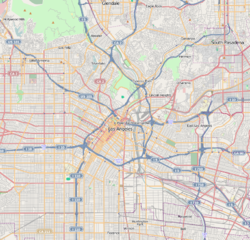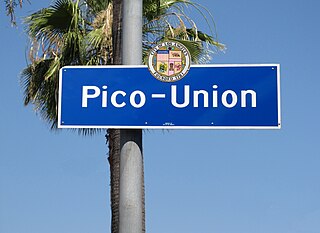
Pico-Union is a neighborhood in Central Los Angeles, California. The name "Pico-Union" refers to the neighborhood that surrounds the intersection of Pico Boulevard and Union Avenue. Located immediately west of Downtown Los Angeles, it is home to over 40,000 residents.

West Adams is a historic neighborhood in the South Los Angeles region of Los Angeles, California. The area is known for its large number of historic buildings, structures and notable houses and mansions.

Jefferson Park is a neighborhood in the South region of the City of Los Angeles, California. There are five Historic-Cultural Monuments in the neighborhood. In 1987, the Jefferson branch library was added to the National Register of Historic Places.

Angelino Heights, alternately spelled Angeleno Heights, is one of the oldest neighborhoods in Los Angeles. Situated between neighboring Chinatown and Echo Park, the neighborhood is known for its concentration of eclectic architectural styles from three eras: The Victorian, Turn of the Century and Revival eras. Carroll Avenue is listed on the National Register of Historic Places and there are over thirty Historic-Cultural Monuments in the neighborhood.

Historic Filipinotown is a neighborhood in the city of Los Angeles. It is one of the six Asian Pacific Islander neighborhoods in the city.

Rómulo Pico Adobe, also known as Ranchito Rómulo and Andrés Pico Adobe, was built in 1834 and is the oldest residence in the San Fernando Valley, making it the second oldest residence in Los Angeles. Built and owned by the Pico family of California, a prominent Californio family, the adobe is located in the Mission Hills section of the city and is a short distance from the San Fernando Mission. It was listed on the National Register of Historic Places in 1966.

The former First Church of Christ, Scientist, built in 1912, is a historic Christian Science church edifice located at 1366 South Alvarado Street in Pico-Union, Los Angeles, California.
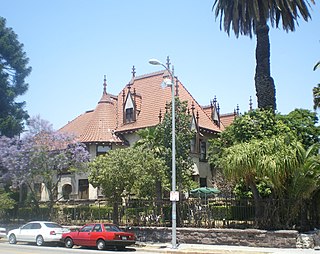
Susana Machado Bernard House and Barn is an elaborate 10,000-square-foot (930 m2) Art Nouveau Gothic Revival style mansion and carriage house located in the Pico Union section of Los Angeles, California. Built in 1901, the house was designed by architect John B. Parkinson (1861–1935). Parkinson also designed the Los Angeles Memorial Coliseum, Union Station and Los Angeles City Hall. Noted for its Gothic style with soaring spaces, the house has vaulted ceilings and curved walls. In 1979, it was designated a Los Angeles Historic-Cultural Monument, and listed on the National Register of Historic Places. The property was purchased in 1996 by the Center for Human Rights & Constitutional Law. Since 2002, the house has been operated as the Casa Libre/Freedom House, a fourteen-bed shelter for homeless minors. In May 2003, the Los Angeles Times profiled the shelter, noting the following: "Casa Libre/Freedom House occupies a newly renovated mansion near MacArthur Park. Registered as a state, county and federal historic site, the home's gothic facade rises elegantly from the corner of South Lake Street and James M. Wood Boulevard. The shelter arranges for schooling, counseling, and medical care for undocumented and unaccompanied immigrant children, mainly from Latin America.

The Menlo Avenue–West Twenty-ninth Street Historic District is a historic district in the North University Park neighborhood of Los Angeles, which is itself part of the city's West Adams district. The area consists of late Victorian and Craftsman-style homes dating back to 1896. The area is bounded by West Adams Boulevard on the north, Ellendale on the east, West Thirtieth Street on the south, and Vermont Avenue to the west. The district is noted for its well-preserved period architecture, reflecting the transition from late Victorian and shingle-styles to the American Craftsman style that took hold in Southern California in the early 1900s. The district was added to the National Register of Historic Places in 1987.

The North University Park Historic District is a historic district in the North University Park neighborhood of Los Angeles, California. The district is bounded by West Adams Boulevard on the north, Magnolia Avenue on the west, Hoover Street on the east, and 28th Street on the south. The district contains numerous well-preserved Victorian houses dating back as far as 1880. In 2004, the district was added to the National Register of Historic Places.

Victoria Park is a small neighborhood in the central region of Los Angeles, California. There are three Los Angeles Historic-Cultural Monuments located in Victoria Park.
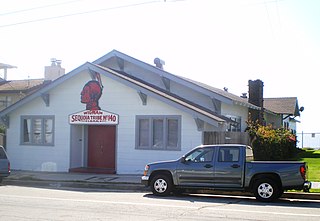
The Red Men Hall, listed as the Redmen's Hall, is a historic structure that houses a fraternal organization near the coast in the San Pedro community of Los Angeles, California.

Pomeroy Wells Powers was an attorney and property developer in Kansas City, Kansas, and Los Angeles, where he was president of the Los Angeles City Council from 1900 to 1902.
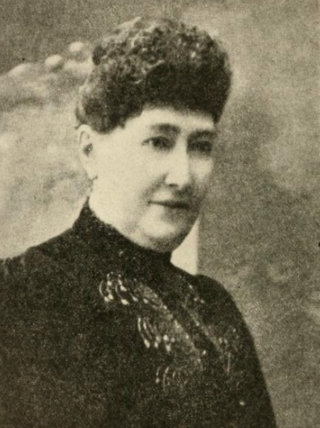
Doria Deighton-Jones was a Scottish-born American landowner and property developer in Los Angeles who built a "vast estate in and around" the city while the city was in its infancy.

Angelus Vista is a neighborhood in Los Angeles, California. There is one Los Angeles Historic-Cultural Monument in neighborhood.
West Adams Terrace is a neighborhood in Los Angeles. Dating back to 1905, it contains seven Los Angeles Historic-Cultural Monuments, one property on the National Register of Historic Places and one Green Book property. In 2003, the neighborhood was designated a Historic Preservation Overlay Zone.

